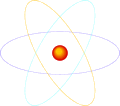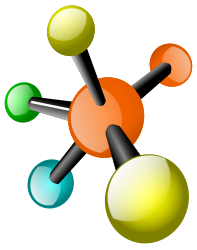Or search by topic
Number and algebra
Geometry and measure
Probability and statistics
Working mathematically
Advanced mathematics
For younger learners
Published 2008 Revised 2011
The Random World
Did you know that
the world is locked in a
perpetual struggle between order and chaos. Don't worry, nature is
designed in this way. To explore these ideas, read on..
..
Take a look around the room in which you sit. Does the room look
the same as yesterday, or are there differences? Perhaps it is
towards the end of the day and things have become untidy; perhaps
it is the start of the day and things are neatly in their place.
Take a look out of the window. Is the weather the same as
yesterday, or is it different? Which is more likely to have
changed? The weather, or the room? Whilst it is tempting to say
that the weather is more changable than the room, both will have
changed to some degree, but both will also be similar to some
degree. Do you think that it makes sense to say that one has
changed more than the other?
In fact, the entire physical world is continually subject to
change at either the microscopic (small) or macroscopic (large)
level. Consider something which does not appear to be changing,
such as your desk. Imagine looking closer and closer at the desk
through a microscope. As you reach down to the scale of the
molecules in the desk you would see that they are continually
oscillating and vibrating: the entire structure of the desk is
vibrating, yet forces between the molecules keep the desk roughly
in the same place, so that, at our human level, the desk appears to
be inert. Consider the wind. A leaf or piece of dust on a windy day
is blown this way and that, backwards and forwards, up and down.
The molecules in the air also vibrate continuously, yet are not
bound to each other by atomic forces, they are free to move
independently of each other. Yet, despite this inter-atomic
freedom, the wind, roughly speaking, will be moving in one overall
direction at any given moment in time. In short, the world is in a
constant struggle between order and chaos: at any level you will
simultaneously see some order and some chaos.
We live in a world of scales at around 1,000,000,000 times bigger
than the world of atoms. Like small  children,
atoms are absolutely never still: they always vibrate and move, and
the hotter they are, the more vigorously they move and vibrate.
Atoms, also like many small children, like to live in groups called
molecules: they are attracted together in various complicated ways,
studied by chemists, to form molecules. However, atoms, and
molecules, also do not like to be too close to each other: when
they get very close, atomic forces cause a repulsion, like two
North poles of a pair of magnets repel each
children,
atoms are absolutely never still: they always vibrate and move, and
the hotter they are, the more vigorously they move and vibrate.
Atoms, also like many small children, like to live in groups called
molecules: they are attracted together in various complicated ways,
studied by chemists, to form molecules. However, atoms, and
molecules, also do not like to be too close to each other: when
they get very close, atomic forces cause a repulsion, like two
North poles of a pair of magnets repel each  other. All
matter is continually in tension between this attraction and
repulsion. Whilst it is impossible to keep track of the individual
motion of the molecules, on average the molecules in a solid, such
as a desk, stay in roughly the same place. From our perspective the
desk is unchanged.
other. All
matter is continually in tension between this attraction and
repulsion. Whilst it is impossible to keep track of the individual
motion of the molecules, on average the molecules in a solid, such
as a desk, stay in roughly the same place. From our perspective the
desk is unchanged.
In short, at its very foundation, the physical world is full of
randomness, but within this randomness emerges some averaged order.
Mathematicians studying random processes need to try to find
structure within the randomness: whilst individual elements of a
problem will vary at random, can we describe with some quantified
degree of certainty an overall outcome?
Even the most trivial of random processes become complicated when
considered in detail. The simplest example of a random process is
the tossing of a coin: flip a coin and it lands heads or tails.
Typically, we say that the chance of heads or tails is fifty-fifty;
toss a coin one time and one result is just as likely as the other.
Is this exactly fifty-fifty? If you look at a coin then it is not
the same on each side; one side has the raised image of a head and
one has a different raised image. Are both sides exactly the same?
I can easily balance a coin on its edge; could the coin not land on
its edge every so often when tossed? Does this alter the odds of a
head? At what point in time does the result of the coin toss become
a certainty? When it has completely come to rest (according to the
human eye, at least)? Watched under slow motion, the coin will
gradually come to a stop with a few small bounces, maybe whilst
spinning. Once these bounces are small enough, we would be able to
predict with more certainty the outcome of the toss, yet the coin
has not come to rest. In fact, extrapolating backwards, if we took
a snapshot of the motion even before the coin has hit the ground
for the first time, would we be able to analyse the motion on a
computer to be able to work out whether the coin was going to land
face up or face down?


Another, often quoted, example of a random process is that of
radioactive decay: a lump of radioactive material, such as uranium,
will, over time break up into pieces, emitting radiation. This is
more than simply the lump of uranium falling into two pieces:
individual atoms split apart, forming new atoms, such as iron. At
the sub-atomic level, matter fundamentally evolves according to
random laws, called quantum
mechanics . Quantum mechanics states that any certain
prediction is not just difficult but impossible: atoms are likely
to follow certain set-paths, but could, randomly, do literally
anything. For example, if all atoms in your desk spontaneously
moved left by 2cm, then your entire desk would move left by 2cm.
However, the chance of anything so exciting occurring is impossibly
small, as atoms are just as likely randomly to move to the left as
to the right: overall, the random motions almost exactly cancel out
in a solid, leaving an apparently static structure.
In the study of any random process, there is a balance to be made
between the major effects of the problem and minor complexities.
Once this balance is correctly struck, mathematicians are able
meaningfully to model the order which underlies the chaos of the
real world. Their predictions are powerful and wide ranging.
You may also like
Rain or Shine
Predict future weather using the probability that tomorrow is wet given today is wet and the probability that tomorrow is wet given that today is dry.
Knock-out
Before a knockout tournament with 2^n players I pick two players. What is the probability that they have to play against each other at some point in the tournament?
Squash
If the score is 8-8 do I have more chance of winning if the winner is the first to reach 9 points or the first to reach 10 points?

